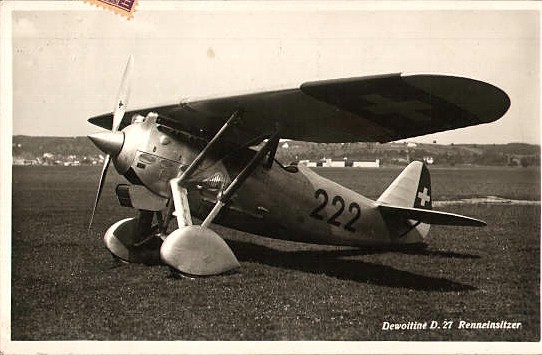The design that took Emile Dewoitine's parasol fighter formula to the apex of its development was the D 27, which was evolved to meet the requirements of the French Air Force 1926 C1 leger programme for lightweight fighters. Adhering closely to the structural concept of preceding fighters, but embodying much aerodynamic refinement and a split-axle (with independently articulated wheels) rather than cross-axle undercarriage, the D 27 was powered by the 493hp Hispano-Suiza 12Mb twelve-cylinder Vee engine and had an armament of two synchronised 0.303in guns. The liquidation of the Construction Aeronautique E Dewoitine in January 1927 resulted in the transfer of development of the D 27 to the EKW in Switzerland, where a prototype flew on 3 June 1928. By the end of the year, three had been ordered by Romania, one by Argentina and four by Yugoslavia and the prototype was undergoing evaluation by the Swiss Fliegertruppe. Seven strengthened versions served experimentally with the French Escadrille 7C1, flying from the aircraft carrier Béarn. The Schwitzerlands D 27 served as first-line fighter until 1940, when they were relegated to tuitional tasks, being finally scrapped in 1944. The Chinese used this aircrafts against Japan in early 1930´s. (source:
http://www.aviastar.org/air/france/dewoitine_d-27.php)
General characteristicsProduction Period: 1929 - 1931
Number of Produced: 20 + 46 conversion
Maiden Flight: 1929
Crew: 1
Empty Weight: 1038 kg (2288 lb)
Take-off Weight: 1414 kg (3117 lb)
Wingspan: 10,300 m (33ft 9,5in)
Length: 6,560 m (21ft 6,22in)
Height: 2,790 m (9ft 2in)
Wing Area: 17,55 m
2 (188.91 ft
2)
Wing Loading: 80,570 kg/m
2 (16.5 lb/ft
2)
Number of Engines: 1
Type: Hispano-Suiza 12Mb twelve-cylinder liquid-cooled Vee engine, rated at 423 kW (567 hp) for take-off and nomimal power 368 kW (493 hp) at 2,000 rpm
Propeller: two-blade fixed-pitch wooden propeller
Maximum Speed: 298 km/h in 0 m (185.2 mph in 0 ft)
Cruise Speed: 250 km/h in 1500 m (155.3 mph in 4921 ft)
Climb Rate: 10,0 m/s (1968.5 ft/min)
Service Ceiling: 8300 m (27 231 ft)
Range: 425 km (264.1 mi)
Armament: Two fixed forward-firing caliber 7,7 mm (0.303 inch) machine-guns above the engine (Vickers?)











